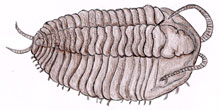
The horseshoe crab (Limulus polyphemus), is the oldest living fossil in Maryland. Horseshoe Crabs evolved much earlier than humans or the Chesapeake Bay. Fossils of horseshoe crabs have been dated at 445 million years old.
They evolved in the shallow seas of the Paleozoic Era (540-248 million years ago) with other primitive arthropods called trilobites, a long extinct close relative of the horseshoe crab.
The age of the dinosaurs, Mezozoic Era, began about 200 million years ago. During this period, dinosaurs dominated the landscape as most species of marine reptiles became extinct. Also, the first mammals appeared.
At this time, the shallow seas around Europe were considered the dispersal point for ancestors of our modern day horseshoe crab species. At the end of the Era, a major extinction of the dinosaurs and about half of the planet's marine invertebrates occurred.
The Horseshoe Crab survived this time of change.
 The Cenozoic Era ushered in the age of Mammals and Flowering Plants. Terrestrial and marine mammals evolved as did our large diversity of flowering plants. This era experienced several ice ages and the continents took their current form. Humans have flourished and still the horseshoe crab survives to this day.
The Cenozoic Era ushered in the age of Mammals and Flowering Plants. Terrestrial and marine mammals evolved as did our large diversity of flowering plants. This era experienced several ice ages and the continents took their current form. Humans have flourished and still the horseshoe crab survives to this day.
To learn more, visit the links on the left.